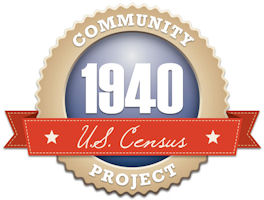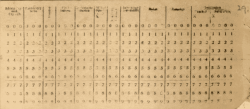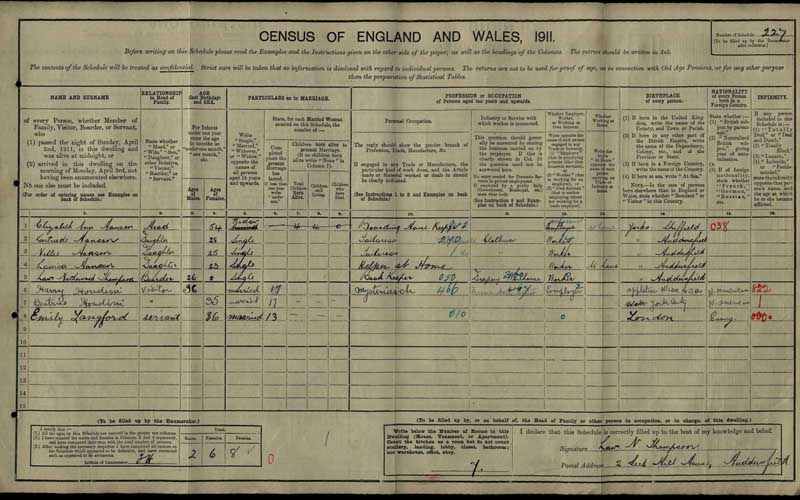 Just over a year ago the 1940 census of the United States was released, causing much excitement and activity in the genealogical community there. Unlike recent census releases in the UK, it did not arrive fully indexed, but as soon as the census images were made public a massive crowd-sourcing project got underway to create name indexes. This is no mean feat since that census contains over 132 million names. The project was jointly undertaken by FamilySearch and by two commercial companies, findmypast.com and Archives.com with batches being allocated to volunteer transcribers and moderators using FamilySearch indexing software. The enthusiasm of the volunteers exceeded expectations, and the whole project was completed ahead of schedule within a few months. Quite independently of this, two other companies, Ancestry.com and MyHeritage.com, also compiled their own indexes.
Just over a year ago the 1940 census of the United States was released, causing much excitement and activity in the genealogical community there. Unlike recent census releases in the UK, it did not arrive fully indexed, but as soon as the census images were made public a massive crowd-sourcing project got underway to create name indexes. This is no mean feat since that census contains over 132 million names. The project was jointly undertaken by FamilySearch and by two commercial companies, findmypast.com and Archives.com with batches being allocated to volunteer transcribers and moderators using FamilySearch indexing software. The enthusiasm of the volunteers exceeded expectations, and the whole project was completed ahead of schedule within a few months. Quite independently of this, two other companies, Ancestry.com and MyHeritage.com, also compiled their own indexes.
I indexed a few batches myself, because I thought it was a worthwhile project, but also because I have an interest in American records. My own ancestry is all Scottish and Irish so far, but learning about American records is useful to me because I keep finding distant relatives whose families migrated there in the 19th and 20th centuries, and I have an American daughter-in-law. It’s also relevant to the day job, since many Americans have British or Irish roots, and when I am answering their research enquiries on British records it helps to know a little about the kind of records they are used to.
Nationwide or federal censuses have been taken in the USA every ten years since 1790. In Great Britain there has been a census every ten years since 1801, with the exception of 1941, and in Ireland every ten years from 1821 to 1911. There was no Irish census in 1921 because of the Troubles, but a census was taken in 1926 in both the Irish Free State and Northern Ireland. There is a lot more US census to look at, and not just because it is a much bigger country. There are lists of names all the way back to 1790, albeit names of heads of households only before 1850, while in Great Britain no name lists at all were collected centrally until 1841 (although some lists from 1801 to 1831 do survive in local archives). But there is also a great deal of extra census material in the USA, including state censuses, often taken half-way between the federal censuses. There are also ‘Non-population’ returns for some years, recording details about agriculture and manufacturing.
Superficially, censuses in the USA and the British Isles are quite similar, in that they list individuals by name, with details of age, occupation and birthplace, and varying amounts of other information depending on the census year. There are, however, some significant differences too; not every individual was listed in every US census, only free people were listed by name, so it was not until 1870, the first census after the Civil War, that all formerly enslaved people were properly listed. Every US census also asked about a person’s ‘Race or color’, while there are no questions about ethnic origin in any British census until 2001. Birthplace information in a US census can be simultaneously more helpful and less helpful than in a British one; in the US census you will only ever find the state or country of birth, not the town or even the county, but as a bonus you will often get the country or state of birth of each person’s parents. In some years the year of arrival in the US is recorded, also if and when a person was naturalised. This information is like gold dust to American genealogists who are looking for the origins of their immigrant ancestors. You might also find information about property, and even earnings, which is never included in Britain
But perhaps the greatest difference is one which is not immediately apparent: the way that the census was taken in the first place. In Britain the enumerator left a paper (schedule) for every household to fill in, which was later collected and the details copied into an enumeration book, except for 1911 in England and Wales when the schedules were kept instead, and the statistical information extracted directly from them. In America there were census takers who gathered information from each household and wrote up the answers. In both countries the census returns were microfilmed (except for 1911 in England and Wales when scans were made directly from the paper schedules). Although all censuses held here at The National Archives are now viewed online, we still have the films as a back-up, and in rare cases we can even refer to the paper originals, which are mostly stored off-site, if a query cannot be resolved using the online or film versions. When I asked about the original paper versions of the US censuses, I was told by a respected genealogist there that the National Archives (NARA) in Washington only held the film versions. If this is true, that is a shame, although you can appreciate the storage problems that would be involved in storing that amount of paper. Despite the fundamentally different ways in which the census was taken on each side of the Atlantic, we in the UK did take the lead from the US in adopting a machine method of tabulating the census. It was first used there in 1890, and was adopted here in 1911 using Hollerith machines and punch cards that were remarkably similar to those I used when I started work in the 1970s!

1911 Census punch card
American censuses are opened after 72 years, while in the UK and Ireland it is something like 100 years. I use the term ‘something like’ advisedly because there have been numerous exceptions; the 1841 and 1851 censuses for England and Wales were first released in the 1920s, thanks to the lobbying efforts of the Society of Genealogists, and in Ireland the censuses of 1901 and 1911 were released well before time, as a kind of consolation prize for the destruction of most of the 19th century returns. This led to the anomalous situation for several years where censuses for Northern Ireland were available to view in the National Archives in Dublin, but not in the Public Record Office of Northern Ireland in Belfast. When I started my own family history research in the 1980s the Scottish 1891 census was already open, but I had to wait until January 1992 to see the returns for England, Wales, the Channel Islands and the Isle of Man. More recently, as the result of a challenge under the Freedom of Information Act, it was England and Wales’ turn to have a census opened earlier than scheduled, when the phased release of the 1911 census began in January 2009, instead of January 2012. The Scottish Freedom of Information Act was worded differently, so the 100-year rule had to be observed, but as a concession the 1911 census for Scotland was released in April 2011, exactly 100 years after it was taken, rather than the customary January of the following year. And recently the government of the Republic of Ireland has agreed to the early release of its 1926 census.
There are ‘missing’ censuses on both sides of the Atlantic, notably the 1890 census of the USA, and most pre-1901 Irish returns. The effects of missing censuses on the British mainland are yet to be felt, since the major loss was the 1931 census for England and Wales, Channel Islands, Isle of Man etc. which was destroyed by fire during the Second World War. The Scottish census, which was administered and stored in Scotland, was not affected. The census of 1941 was never taken, because of the war, although a kind of census was taken in September 1939 for National Registration.

Audrey,
Many thanks. I do find the American censuses very difficult to look at as the lines are so small and you have to scroll across the page remembering what the columns represent. It is useful that the American census does have the approximate value of the properties, interesting for the Hollywood area, e.g. comparing Cecil B de Mille and Charlie Chaplin. It also confirms recent information that Loretta Lynn (‘The Coalminer’s Daughter) was born in 1933 rather than 1935. I am sure there will be those who will seek earlier release in the UK.
It is regrettable that in Scotland the original 1911 census forms were not kept but at least they were transcribed to a level we expect. Given that Scotland had morre time to transcribe the whole census was released at the same time and not in stages as in England and Wales. The information on place and dates of birth in the American census are important because the US does not have a central equivalent of the General Register Office where we can put in an ancestor’s name and find where they were registered, much better than having to lift those heavy quarterly volumes at St Catherine’s House. The only downside to the digitisation (apart from transcription accuracy) of the UK censuses is that local family history societies can’t get microfilm entries of their local area for local history purposes.
Would it be possible to name the “famous American in the 1911 census”? When I try to zoom in it just gets blurry.
Something to note about the U.S. censuses is that because they used to be taken by workers going house to house, non-English names were sometimes quite mangled, or simply spelled however was most convenient for the worker. This can lead to great frustration for modern genealogists, to put it mildly.
Hi Pat, thank you for your comment. We’ve amended the image caption to show Harry Houdini’s name, and you should now be able to click on the image for a bigger version. Houdini is the 6th entry.
How do I go about getting the 1891 census in
England
Hi Dorothy,
Please see our online guidance on looking for census records.
Thanks,
Am I understanding correctly from this? Was the 1911 census not microfilmed? It has always been a boon to local researchers like myself to have free access to the microfilm copy which, although not always easy to read, did not suffer from the additional transcription errors introduced by the LDS (1881) and on-line companies.
Would it not be possible to produce copies of census returns on CD for local libraries and family history societies to purchase in the same way as they have previously with the microfilms?
The issue of the 1911 census microfilm is something which I recall being discussed by interested parties and complained about and it is not just TNA but also Scotland’s People that have not allowed access and that the online service is unuseful for local history purposes. As someone who sponsored one of the microfilms for Strichen in Aberdeenshire for 1901 but we are not allowed to buy the 1911 census. It is regrettable that TNA send copies to companies whose record of transcriptions (like mis-spelling of New York) has happened, let aalone the lack of any transcriptions at all.
I agree about allowing people to have cds of local entries especially when another 10% set of cuts is announced by the Government, as long as the price is reasonable and covers TNA’s costs.
The 1911 census for England and Wales isn’t ‘unuseful’ for local history purposes. You can search by place name in Discovery, our online catalogue, restricting your search to series RG 14, to find out which pieces cover the parish or district you are interested in. You can then browse the images on Findmypast.co.uk, starting at Schedule no 1 for each piece, using the census reference search facility. The household schedules then link to the Enumerators’ Summary Books, which contain district descriptions as in the Enumeration Books in previous census years and details not mentioned in the household schedules, such as descriptions of types of dwelling and of uninhabited buildings.
Although there is no microform version of the 1911 census, local record offices can purchase images of the pieces for their area, and a number have done so. Because of the way that the 1911 census was conducted, with the retention of all the household schedules, there are far more images than in previous census years. Assuming no increase at all in population, there are approximately 8 times as many images in 1911 as in 1901 for each district.
You can use Discovery but then you either have to pay to look at the images on Find My Past or go to Kew and find that there are so many errors on text running when you try to look at the images. There are some advantages to having microfilm copies against digitised images, how long will the digitised images be playable before the technology changes?.
It is a shame that the records had not been microfilmed in the 1960s when it was suggested.
For the last several UK censuses – I don’t know exactly how many, people’s birth places have not been given – just the country in the UK you were born in, or a country overseas. That’s a pity as “Scotland” could mean anywhere from Shetland to just north of the border or the Western Isles to the east coast. Not very helpful for genealogists.
Also, in 2011, we were instructed just to write our first name and surname on the census form – no middle names. This wil be frustrating for future genealogists – imagine looking for you ancestor John Cadwallader Nathaniel Smith when he just did as he was told and wrote John Smith. Actually, I put my middle name in too – and the online census software accepted it.
I agree with Dallas Carter that the information in the censuses of recent date are not useful for genealogists/family historians and that the Government decided not to ask for the information. The reason may go back to the 1960w and 1970s when the issues of privacy and computers arose (there are quite a few files at The National Archives on this subject) and the public’s mistrust of Government assurances in 1911 when they went back on the confidentiality undertaking not to use the data to calculate entitlements to Old Age Pensions and the missing entries in 1991 as people believed that the Government were using the information for ‘Poll Tax’ purposes. There has always been an issue of defining Scotland in the English and Welsh censuses and similarly in the Scottish censuses of the use of the term of England . It does make you wonder that if the data is ‘secure’ why the Government did not ask for more information and the repeated assurances that the census was coming to an end, does anyone know why it is still being carried out at £x millions.
Insightful piece of writing.
You constantly write the best content pages and as usual Censuses compared | The National Archives blog is certainly no exception to this rule!